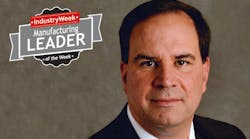“Think about how many things change as the result of unplugging,” said John Gatti, the CEO of ICCNexergy+Palladium Energy. He and his wife were having a discussion about cell phones with their 12-year-old twins. His children asked how they had made calls on the road when he was growing up and he explained how pay phones had once been common. That was a notion, he said, that they found “amusing.”
The disappearance of pay phones is emblematic of the transformation going on in many areas of society, he noted, as products no longer have to be plugged in to a wall socket or other power source. Untethering products changes their design, how they are made and how we use them, whether it be a library of music in our pocket or an X-ray machine that can be brought to wounded soliders.
And, says Gatti, “We haven’t even scratched the surface of things that are still plugged into walls, and things that were never powered to begin with, that can be powered.” He adds, “It’s a very exciting time that we’re in.”
While there are large players producing batteries and power solutions for mobile devices, it is fragmented and suits the “buy and build” philosophy of KRG Capital Partners, a Denver, Colo.-based middle market equity firm. In 2014, KRG purchased ICCNexergy, a Chicago-based manufacturer of battery systems and other products established in 1967.
Then on May 4, KRG announced that it had acquired Palladium Energy Inc., another Illinois-based manufacturer of customized power solutions founded as TDI Batteries in 1973, and would combine the two companies under the leadership of Gatti.
Gatti says the combined company will benefit from both “scale and technical competence.” Together, the two companies operate 14 facilities in four continents and have more than 435,000 square feet of manufacturing space. The company will operate in four markets – commercial, industrial, medical and military/government. Gatti says the combined company is expected to be rebranded before the end of 2015.
Engineering a Portable Future
Do we love our portable electronic devices? Well, consider that in the first quarter of 2015, smartphone manufacturers sold 336 million units globally, according to Gartner, with just Samsung and Apple accounting for more than 141 million phones sold.
Consequently, the market for batteries for smartphones, tablets, laptops and watches is booming. Navigant Research estimates that the market for advanced portable batteries using lithium ion and other technologies will grow to over $12.4 billion by 2023.
Looking at the critical nature of power, Gatti said products can be divided into those that are plugged into the wall and those that are not.
“We are not even in the knee of the curve relative to products being unplugged,” he noted. An important contributor, Gatti noted, is that research continues to improve the power density of lithium-based batteries.
In the recent past, batteries tended to become a commoditized component, Gatti observed, while research focused on other areas of mobile products. But that is changing as markets demand more portable products, and products that are smaller but nevertheless stay powered for longer periods of time. Customers also want to ensure that litihium ion products perform safely. Gatti says that plays to the engineering expertise of ICCNexergy+Palladium Energy.
“The marketplace has become more savvy about that,” he said. “When they seek a company out, they are looking for engineering companies. We have over 300 degreed engineers and four Ph.D.’s as we combine these two companies.”
That technical expertise is vital to ICCNexergy+Palladium Energy’s business development efforts, Gatti said. The company deals with some of the world’s largest OEMs and the contact is frequently through their engineering departments. That’s why engineers are found at every level of the company to facilitate product development, supply chain and technical sales issues.
“It is why we describe ourselves as an engineering team,” said Gatti, himself an engineer.
Gatti notes that lithium power isn’t always delivered through a cell form factor. While ICCNexergy+Palladium Energy does not develop cells, it takes the technology and adapts it to fit with customers’ applications, along with the necessary electronics and software.
Gatti says whether the answer may be a round cell similar to what you would buy at Home Depot, a prismatic form similar to a 9V battery or a pouch cell, akin to a deflated juice bag.
“These can range from a fifth of the size of a dime to something that is very large,” he explains. “Most cells produced today for mobile communications and tablets come in the form of pouches.”
Products that are unplugged require three critical components – a battery, charger and a power supply. Gatti said the combined company is unique in that it can provide an integrated solution in its four target markets.
The extended global reach of the combined company offers an advantage given that shipping lithium requires special handling. Operating in nine countries in four continents, he notes, “provides a logistics footprint that is extremely efficient not only for ourselves but for our customers.”
While ICCNexergy+Palladium Energy is building its global footprint, Gatti says the U.S. remains a good place to manufacture. The company has four operations in the U.S. – Woodridge, Ill., Westchester, Ill., Dublin, Ohio and Denver, Colo. He notes that the U.S. offers “an incredible resource of talent not only at the direct workforce level but throughout the organization – program managers, engineers, quality, finance and the like. We have been very fortunate.”
Building a Team and Trust
Of course, Gatti faces a major task in merging the two companies into a cohesive and effective entity. It is not a situation he is a stranger to, as he has been involved in selling and buying companies throughout his career with companies such as BAE Systems, Raytheon and MicroSun Technologies. That experience has led him to some firm beliefs about how to guide the merger.
“Regardless of whether you are buying or selling, integrating and merging is about recognizing the true value of what you acquired,” he said, and that process starts with people. “It doesn’t matter whether you are working for McDonald's or NASA, people really are the core to success.”
Gatti says the company will follow a structured method in evaluating its talent pool, looking for employees who want to be “owners, not renters.”
“It’s not change that people don’t really like,” says Gatti. “It’s the unknown of change or the lack of control of change. So we go through a process where people decide who we are today and who we want to be going forward so that there is an ownership built throughout the organization.”
While engineering-oriented companies such as ICCNexergy+Palladium Energy thrive on technical talent, Gatti says when the company hires people, the most important factor is character.
It doesn't matter whether you are working for McDonald's or NASA, people really are the core to success."— John Gatti
“If you have talented people with great character, then the chemistry and the culture of the company come together very quickly. I believe it is the most foundational variable for success or failure,” says Gatti.
That character is on display not only in how people work with each other but in how the company deals with customers, Gatti believes.
“Customers want us to be able to perform. It forms the foundation of trust,” he explains. “We say we are going to do X, we do X. When we continue to do everything we say we will do consistently, there is more trust built over time.”




